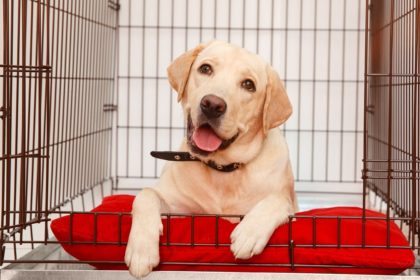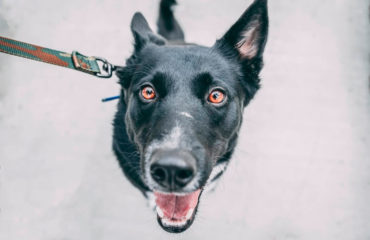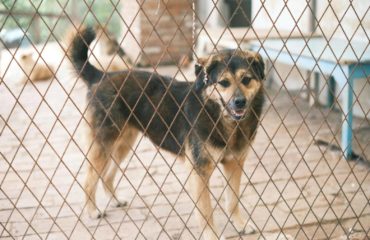How To Approach Crate Training Your Dog

Crates are a great way to provide your dog with a sense of security in many different scenarios. It gives them a safe place to retreat to and remain undisturbed if they feel nervous, tired, or stressed, which can be caused by fireworks, visitors or even just the weather. You can also transport your dog in a crate when travelling to put them at ease when in a new environment.
As well as keeping dogs calm, crates help with toilet training and prevent them from causing any damage to your home when unsupervised. However, without introducing the crate gradually, it can be unnerving for your pooch. To ensure your furry friend associates the crate with positivity and safety, read Benchmark Kennels’ tips on how to conduct the crate training process properly.
What type of crate do you need?
Crates are often made from plastic, metal, or fabric. Deciding which option is best for your dog will depend on your preferences. Metal crates are quite popular as they’re sturdier, escape-proof and often collapsible. Plastic crates are easily cleaned and lighter, which can make travelling easier, but they can absorb odours. Fabric crates are also light for putting in the car but can easily tear and become dirty quickly.

Ensuring the crate is the correct size will make it as comfortable as possible for your pup. It needs to be big enough for your dog to easily stand, turn around, and lie down in, with additional room for bedding, toys, food, and water bowls. However, when crates are too large, dogs sometimes go to the toilet at one end and sleep at the other end unbothered. If you’ve invested in a bigger crate to suit your pup as it grows, partition it to an appropriate size.
As well as indoor crates, you can also buy outdoor kennels which are great for dogs that love spending time outside. Benchmark Kennels offer insulated, sheltered, and secure kennels that are big enough for your dog to sleep and play in.
How to introduce the crate
Place the crate in a family room at first to keep your pooch from feeling isolated. Put blankets or soft towels inside it to make it cosy and cover it with a blanket for extra security.
To encourage them to go into the crate on their own, place treats and their favourite toys inside it and always keep it accessible. Keep the door firmly open, so it doesn’t shut on your dog unexpectedly while he’s exploring. If your pooch is reluctant to go inside, don’t force them and instead place treats and toys just outside the crate and slowly move them inside as your pup gets more comfortable. Reward your pup with praise when he goes inside.
You can introduce commands such as ‘crate’, ‘kennel up’, or pointing to the kennel, so they know when to go in their crate.
The crate should act as a den for your dog to use when they need some rest or privacy, so you should never use it as punishment.
How to feed your dog in the crate
After your dog is comfortable going in and out the crate, place his food bowl nearby and gradually move it inside. Associating the crate with food will help it become a positive experience.
When your pup is comfortable eating inside the crate, begin closing the door as he eats and then as soon as he’s finished, open the door. Keep the door closed for a few minutes longer each time until he’s happy to settle inside after eating with the door shut. If closing the door makes him nervous, begin by half-closing it and take this step slower.
When to leave your dog in the crate outside of mealtimes
Once your dog regularly eats in the crate, you can keep him in there for short intervals of the day while you’re at home. Stay in the room quietly for between five and ten minutes, then leave for a few minutes before returning to let him out. Continue this process a couple of times a day, gradually increasing the time he’s left alone each time until he can stay inside the crate for longer intervals without getting anxious. Then you can leave him in the crate during the day while you’re out, but the safe time limit for this will depend on the dog’s age. Adult dogs shouldn’t be left in there for longer than four hours, while the timeframe for young puppies is 30 to 60 minutes.
Keeping toys and puzzles in the crate will keep your pup entertained and prevent boredom. Try to time this for after they’ve eaten and exercised so that they’re ready to relax.
When you leave and return, make the exchanges with your dog low-key and unemotional to avoid upsetting them when you’re gone. To keep them from associating the crate with being alone, occasionally keep them in it for short intervals when you’re at home.
Train your dog to sleep in the crate
First place the crate in your bedroom or just outside the room. Once your pup is sleeping comfortably in there, gradually move the crate each night until you reach the preferred location.
Ensure you use the crate at night consistently because not sticking to a routine can cause confusion and eventually anxiety.
How to react to whining
Crate training can sometimes cause dogs to whine, which may be an indication that you’re progressing too quickly and need to start again or go back a step. Try not to let him out or give him attention until he’s stopped whining, as this would reinforce the bad behaviour. Instead, reward calm behaviour once the whining has stopped.
If you aren’t sure whether your dog’s whining is because he needs the toilet, use your usual toilet training phrase, and take him outside if he responds excitably. Encourage your dog to go to the toilet before putting him in the crate but remember that puppies need to release their bladder frequently.
The length of time it will take for your dog to accept the crate fully will depend on their personality, demeanour and upbringing. Puppies can adjust quicker than older dogs, but it also depends on their temperament and your training methods. Be careful not to rush this process as it’s essential for you to approach it slowly and not cause your pooch any stress that can develop into long-term problem behaviours.
Need a bespoke kennel for your dog to feel comfortable outside?
Benchmark Kennels are a manufacturer of bespoke kennels, giving dogs a secure and spacious place to stay outdoors when they need some peace and quiet. Each kennel can be customised to suit your dog and home perfectly in terms of size, shape and material.
You can order a wooden or WPC eco-thermal dog kennel directly from our website today or contact us via phone to find out more about our excellent range of kennels.





You must be logged in to post a comment.